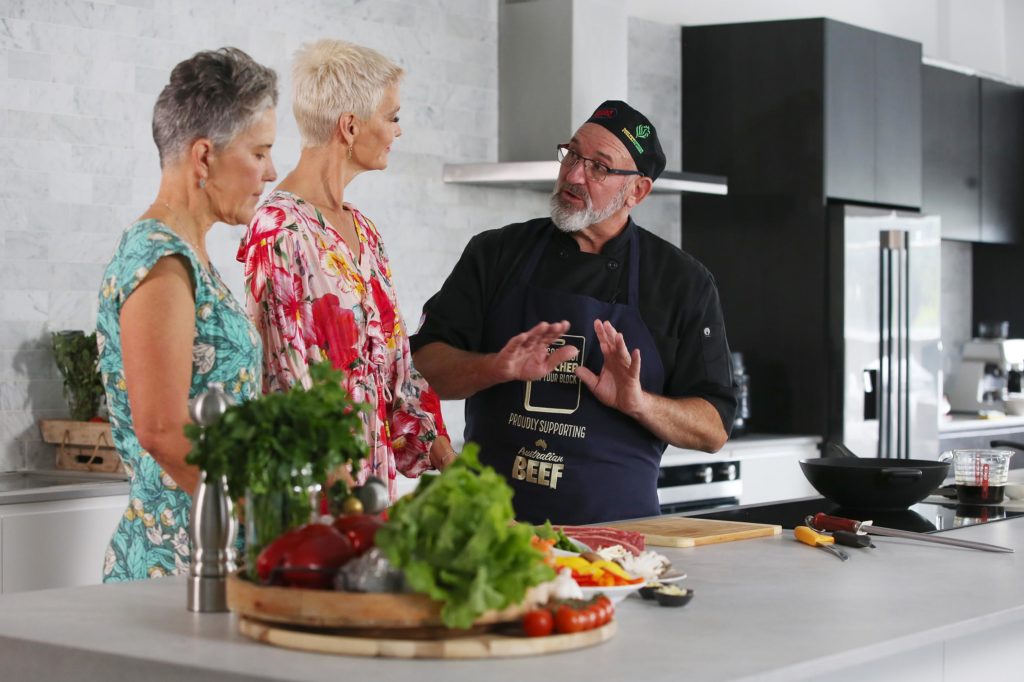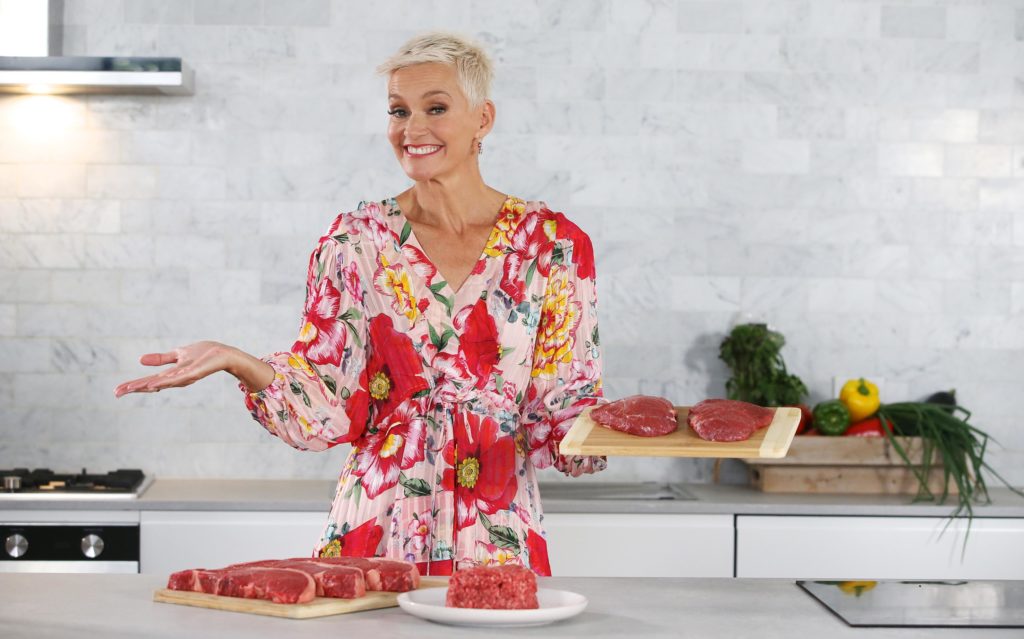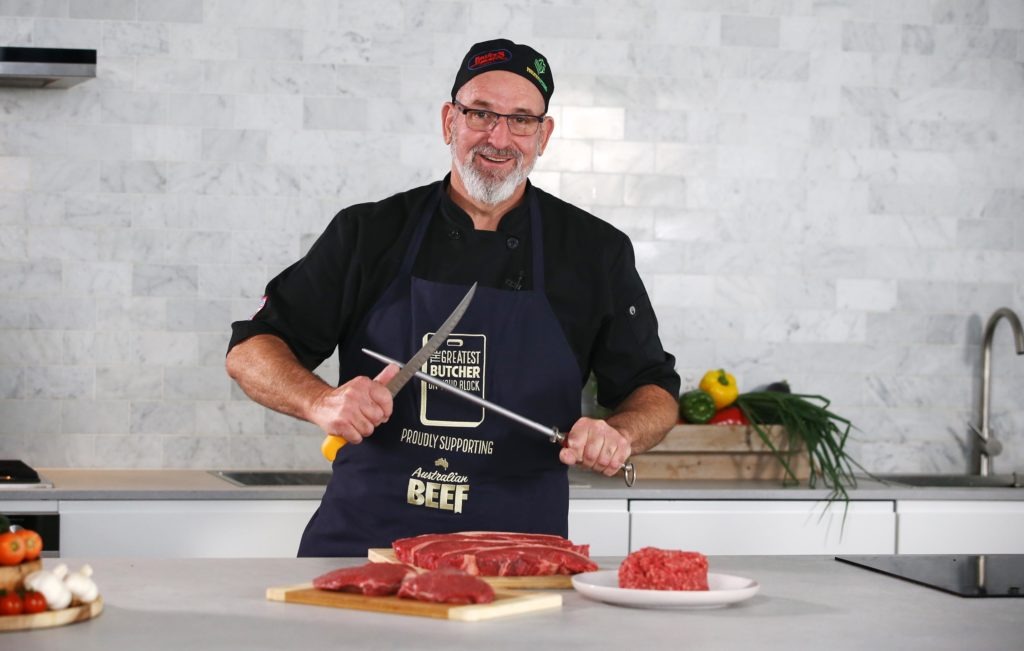The greatest butcher, the greatest beef
This winter, Meat & Livestock Australia is heroing Australian independent butchers by once again partnering with media personality and self-dubbed “crap housewife” Jessica Rowe, along with the red meat industry’s lead dietitian Veronique Droulez and top Adelaide butcher Trevor Hill. The trio will be sharing tips on cooking with beef, nutrition advice and healthy, tasty beef recipes that will impress whomever you dish them up to.
All the Greatest Butcher campaign recipes will be featured in butcher shops and on the Australian Beef website. They aim to help promote red meat’s versatility and showcase why Australian beef is a great choice for a healthy, balanced meal three to four times a week.

Just ask your butcher
Rowe has been spending time in the kitchen of late with Trevor Hill from Bruce’s Meats in Adelaide, who has been teaching her how to create simple, tasty meals with Aussie beef.
“I’ve always struggled with cooking,” Rowe says. “And many people lack confidence when it comes to cooking with red meat. But the key is simple – talk to your local butcher, because they know what to do. They can give you easy-to-follow tips. They tell you what temperature to cook at, how long to cook your meat, what to serve it with.
“I’m a crap housewife; I’m not the expert. I rely on experts to help me. And I know that by talking to your local butcher, asking them for advice, they can make it simple for you.”

Steak your claim
When it comes to how your butcher can help you improve your beef skills, Rowe cites the example of cooking a steak which, despite appearing easy when you watch others do it, can become a disaster when you try to cook one at home if you don’t know the best method.
“I could never cook a steak before,” she admits. “Either it’d be chewy or it would be burnt. But then I asked my butcher what cut to choose and how to cook it. He told me to put olive oil on both sides, along with salt and pepper. And depending on the thickness, how long to cook it for. Then all you have to do is cook it for X number of minutes on one side, the same number of minutes on the other, rest it, and then it’s delicious.”
This year, Rowe has learned how to roast a leg of lamb, which she’d never done before. She also learned how to cook a stir-fry, saying that in the past, her stir-fries were a let-down.
“I would always serve up soggy stir fry, and the beef would be chewy,” she says. “I’d be wondering, ‘What have I done wrong?’ But again, by talking to my butcher, I learned to ask them to slice the beef against the grain and to cook the meat in batches. I would just chuck it all in at once, but that’s actually stewing the meat, because you’ve got too much in the pan. By just cooking it in smaller batches, it tastes beautiful.”

From chuck to cheeks
For those on a budget, there are lots of cheaper cuts of beef that taste great. In the cooler winter weather, using chuck steak in a slow-cooked casserole is ideal, as chuck just becomes more tender and juicy the longer you cook it for. When it comes to lesser-known bargain cuts of meat, Rowe has also recently become a fan of beef cheeks.
“I’d never eaten a beef cheek in my life,” she says. “I thought, is it a cheek on the face or the bottom? [It’s the face, BTW.] But slow-cooked beef cheek is tender and delicious.”
Butcher Trevor Hill knows how good slow-cooked beef can be on a cold winter’s evening, and can tell you that there are plenty of great cuts that are perfect for the job.
“Cuts like chuck steak, gravy beef, osso buco and beef cheeks are ideal for long, slow cooking time that gives meltingly tender results,” he says. “They also cost less than quick-cook cuts like porterhouse, scotch fillet, tenderloin or rump that go on the grill in summer.”
Slow-cooking keeps all the natural juices and flavour in, and can be done on the stove or in the oven at a low temperature for three to four hours if you don’t have a slow cooker.
“Another great thing about slow cooks is that you can add in your vegies and stock and cook everything in one pot,” Hill says. “All cuts of beef have the same nutritional value once trimmed of visible fat, so you can enjoy a healthy balanced meal, no matter the cut.”

All you have to do is ask
Your local independent butcher will be happy to help guide you when it comes to selecting your cut of choice to feed you or your family, and there’s no need to worry that they’ll think you’re a bit daft if you’re unsure how to cook a certain cut. Far from it, in fact.
“They don’t think that at all!” Rowe says. “The butchers I’ve met are so passionate about what they do. They love it – many are third or fourth generation family butchers. They want to talk about it, and they want you to enjoy cooking with their produce so that you’ll come back in again, and either use that same bit of Aussie beef or try something else.
“I know that I love a chat, but I also haven’t met a butcher who doesn’t love a chat. And the thing is, it’s their business. They want to help you, they want to guide you. That’s their job, and they really take that very seriously.”
So head to your local butcher’s today and ask them what to make for dinner tonight. They’ll be able to give you plenty of great ideas and advice on what to cook and how to cook it.
For loads of Australian beef recipe ideas, tips and tricks, head to australianbeef.com.au









